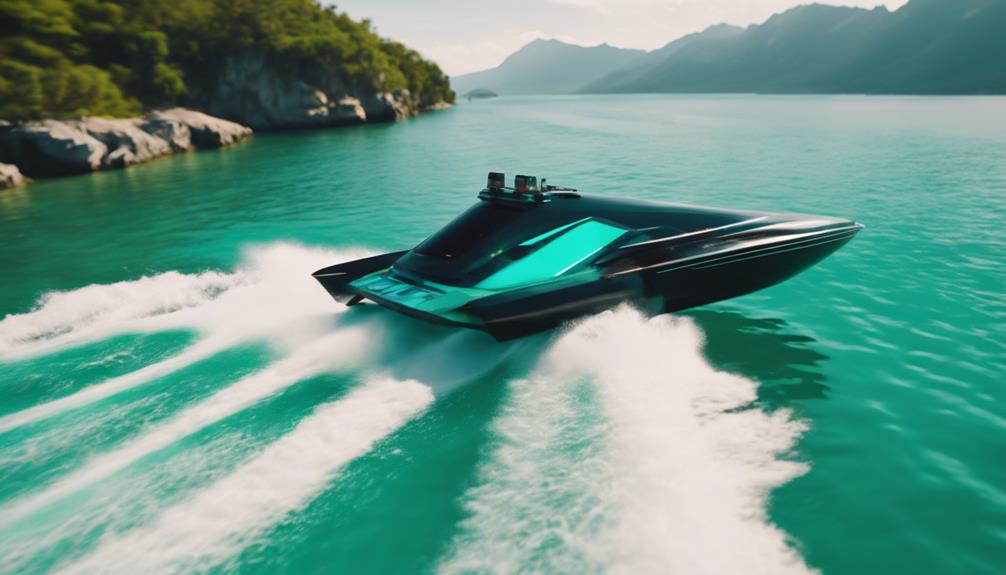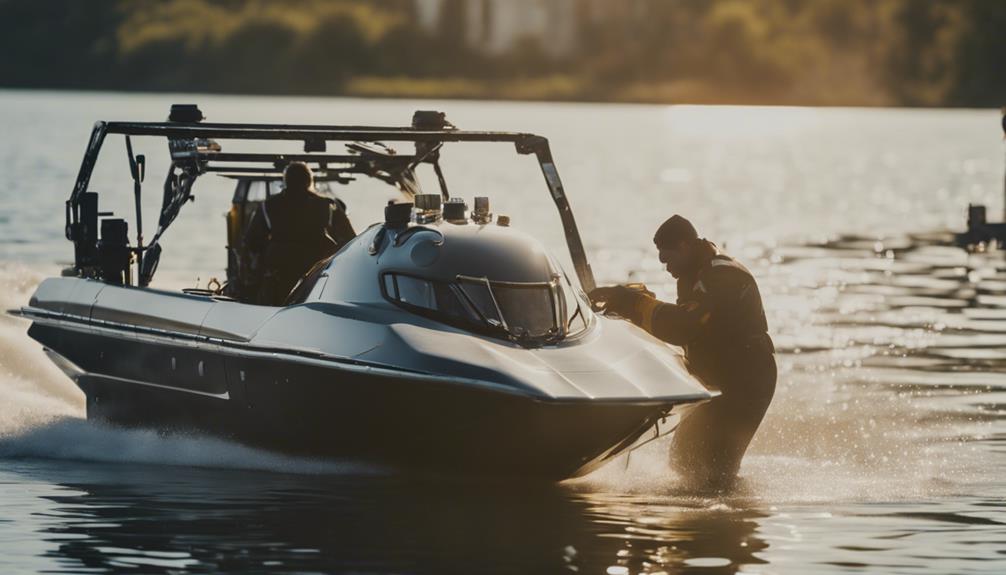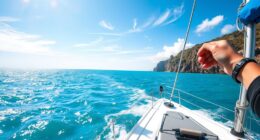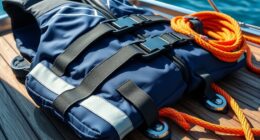The fastest jet boat ever recorded is the Spirit of Australia, achieving a jaw-dropping speed of 511.1 km/h (317.6 mph) on October 8, 1978. Piloted by Ken Warby, this remarkable feat has remained unchallenged for over four decades. The Spirit of Australia is powered by a Westinghouse J34 jet engine, initially designed for jet fighters. Although several contenders, like the Quicksilver and Spirit of Australia II, are attempting to break this record, none have yet succeeded. Want to learn about the latest advancements in jet boat technology and what the future holds for speed records?
Key Takeaways
- The fastest jet boat is the Spirit of Australia, holding the record at 511.11 km/h (317.6 mph) since October 8, 1978.
- Ken Warby designed, built, and piloted the Spirit of Australia, achieving both the 300 mph and 500 km/h speed barriers.
- The record remains unbroken for over four decades, showcasing Warby's engineering excellence and the boat's advanced design.
- Current contenders include Quicksilver and Spirit of Australia II, both equipped with powerful jet engines aiming to challenge the record.
Historical Record Overview
On October 8, 1978, the Spirit of Australia shattered records by reaching an astonishing speed of 511.11 km/h (317.59 mph) on the Tumut River, a feat that remains unmatched for over forty years. Piloted by Ken Warby, this remarkable achievement marked a significant milestone in the history of speed records. The Spirit of Australia became the fastest boat in history, achieving a peak speed of 555 km/h (345 mph) and surpassing both the 300 mph and 500 km/h barriers.
Ken Warby is celebrated as the first Australian to design, build, and pilot a water speed record boat, solidifying his place in the annals of maritime history. The world water speed record set by the Spirit of Australia is officially recognized by the World Sailing Speed Record Council and has remained an unbroken record for decades.
Despite numerous attempts by challengers to surpass this legendary speed, none have succeeded. This enduring legacy not only highlights Warby's incredible skills but also showcases Australia's prowess in the field of speed records, making the Spirit of Australia an iconic symbol of engineering and determination.
Current World Record Holder

The Spirit of Australia still holds the title of the fastest jet boat in history, with its record-setting speed remaining unmatched for over four decades. Piloted by Ken Warby, this incredible boat achieved a two-way average speed of 317.6 mph (511.1 km/h) on October 8, 1978, near the Blowering Dam on the Tumut River in Australia. During this thrilling attempt, the peak speed reached an astonishing 555 km/h (345 mph).
What makes this achievement even more impressive is that Ken Warby designed and built the Spirit of Australia himself, making him the first Australian to accomplish such a feat. Powered by a Westinghouse J34 jet engine, originally designed for jet fighters, this boat broke both the 300 mph and 500 km/h barriers, solidifying its place in the record books.
Despite numerous attempts by other contenders, the Spirit of Australia remains the ultimate example of speed on water, and its world speed record still stands strong. For enthusiasts and speed seekers, it's a benchmark that continues to inspire.
Notable Contenders for the Record

As you explore the world of jet boats, you'll find that Ken Warby's Spirit of Australia still holds the record.
However, several challengers are hot on its heels. Notable contenders like Quicksilver and Longbow are pushing the limits of speed with innovative designs and powerful engines.
With ongoing efforts to break water speed records, the future looks exciting for these competitors.
Current Record Holder
Holding the record for the fastest water speed, the Spirit of Australia achieved an impressive average speed of 317.6 mph (511.1 km/h) back in 1978. Since then, several notable contenders have emerged, enthusiastic to challenge that mark. Piloted by Ken Warby, the Spirit of Australia still stands as the ultimate benchmark for water speed enthusiasts. This record, recognized by the Guinness World Records, has sparked numerous record attempts from various teams.
One notable contender is Quicksilver, led by Nigel Macknight. It features a powerful 10,000hp Mk 101 jet engine, but it has faced stability issues during testing.
The Spirit of Australia II, developed by Ken and David Warby, is another fierce competitor, boasting a 9,000hp Westinghouse J-34 jet engine and reaching speeds of 314 km/h (195 mph) in its tests.
Additionally, the British team behind Longbow, powered by twin Rolls Royce Viper engines, is making strides with technical support from David Warby.
Major Challengers Overview
Several major challengers are fiercely competing to break the longstanding water speed record set by the Spirit of Australia, each bringing unique technology and ambition to the race. The current record holder, Ken Warby, still holds the title with an astonishing speed of 511.11 km/h (317.59 mph) achieved in 1978.
Among the notable contenders for the world record is Quicksilver, led by Nigel Macknight, boasting a powerful 10,000hp Mk 101 jet engine and ongoing design enhancements since its inception in 2002.
Another serious competitor is the Spirit of Australia II, developed by Ken Warby and his son David. This boat recorded an impressive testing run speed of 314 km/h (195 mph) in 2018, signaling its potential to challenge the existing record.
The Longbow project, piloted by David-John Gibbs and supported by David Warby, features twin Rolls Royce Viper engines and aims to join the ranks of the world's fastest boats.
Future Record Attempts
Notable contenders are actively gearing up for future record attempts, each bringing cutting-edge technology and determined ambition to the water speed challenge. As they prepare to break the world record, here are some key players to watch:
- Spirit of Australia II: Developed by Ken Warby and his son David, this boat features a 9,000hp Westinghouse J-34 jet engine and achieved a testing run speed of 314 km/h (195 mph) in 2018.
- Quicksilver: Led by Nigel Macknight, this British contender boasts a 10,000hp Mk 101 jet engine and a kevlar hull, though it currently lacks a launch date.
- Longbow: Piloted by David-John Gibbs, this boat utilizes twin Rolls Royce Viper engines and benefits from the technical support of David Warby, Ken's son.
- Dartagnan SP600: A Belgian project revived after the passing of Daniel Dehaemers in 2018, this team is determined to continue their pursuit of speed records.
With engineering challenges and financial investments at the forefront, these contenders are poised to make waves in the quest for speed supremacy.
Technological Advances in Jet Boats

When you look at jet boats today, you'll notice remarkable engine innovations and performance enhancements that make them faster than ever.
Modern designs incorporate advanced aerodynamics and lightweight materials, allowing for improved speed and efficiency.
These technological advances are key to pushing the boundaries of what's possible on water.
Engine Innovations and Performance
Engine innovations have dramatically transformed jet boats, enabling unprecedented speeds and performance through cutting-edge propulsion technologies. Ken Warby's Spirit of Australia set the standard back in 1978, breaking the record with a jaw-dropping speed of 511.11 km/h (317.59 mph) powered by a Westinghouse J34 jet engine. This remarkable feat showcased the potential of jet propulsion in watercraft design.
Here are some key advancements in engine technology that have shaped modern jet boats:
- High-Powered Engines: Boats like Quicksilver utilize a 10,000hp Mk 101 jet engine, pushing the limits of water speed.
- Advanced Materials: The use of lightweight materials such as kevlar and Baltek has improved speed and handling.
- Engine Evolution: The Spirit of Australia II employs a Bristol Siddeley Orpheus jet engine, enhancing overall performance since its completion in 2004.
- Revolutionary Designs: Modern jet propulsion systems have replaced traditional propeller-driven mechanisms, allowing speeds that were once unattainable.
These engine innovations continue to propel jet boats into a new era of performance, redefining what's possible on the water.
Aerodynamics and Design Enhancements
Aerodynamics plays a pivotal role in jet boat design, enabling these vessels to slice through water with minimal resistance and achieve remarkable speeds. Innovations in hull design are vital for optimizing hydrodynamics, allowing boats to maintain stability at high velocities. For instance, features like T-Decks and specialized bottom shapes help improve performance by reducing drag.
The use of advanced materials, such as Kevlar and Baltek, is another significant factor. These materials enhance strength while keeping weight low, which is essential for achieving peak speeds. Ken Warby's Spirit of Australia exemplifies how these design elements come together, as it became the first boat to break both the 300 mph and 500 km/h barriers, setting impressive speed records.
Additionally, modern jet propulsion systems, like the Westinghouse J34 and Bristol Siddeley Orpheus engines, provide increased thrust and efficiency compared to traditional propeller-driven boats. By leveraging data collection and analysis techniques, engineers can predict performance and make informed adjustments, paving the way for future record attempts.
These advancements in aerodynamics and design are redefining what's possible in the world of jet boating.
Challenges Faced by Competitors
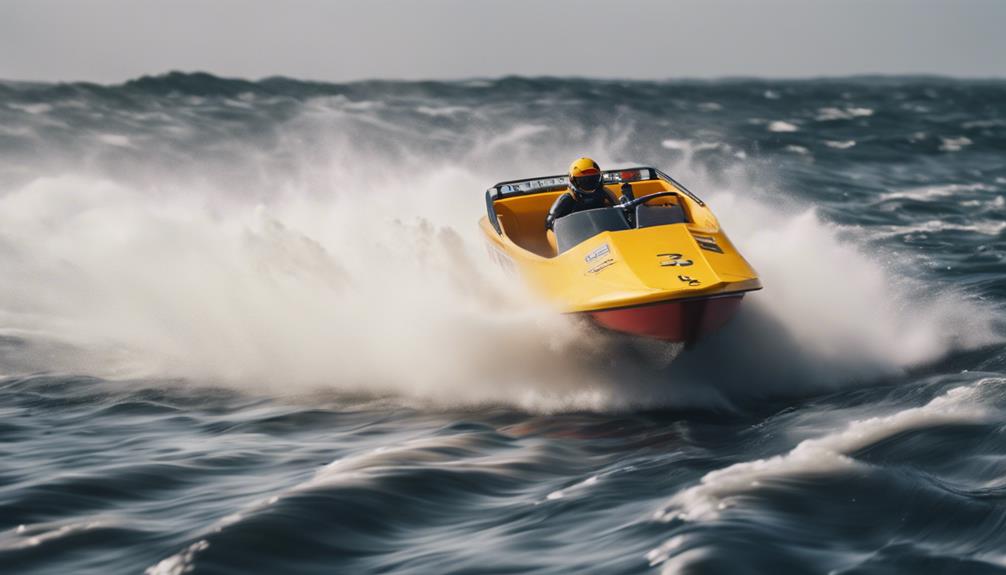
Competing for water speed records presents numerous challenges, from complex engineering demands to the ever-present dangers of high-speed trials. As a competitor, you'll face various hurdles that can make or break your chances of success:
- Engineering Challenges: Creating a jet boat that incorporates advanced aerodynamics is critical for achieving high speeds safely.
- Safety Measures: Although safety standards have improved, the inherent risks remain significant, with an alarming 85% death rate among competitors.
- Environmental Conditions: Wind and water surface turbulence can drastically impact performance, making thorough testing essential before any record attempts.
- Financial Investments: Developing the sophisticated technology and materials for these jet boats requires substantial financial backing, which can deter many potential challengers.
Navigating these challenges demands not just skill but also significant preparation and a willingness to accept the risks involved.
Your journey through the world of water speed records will test your limits and resilience, making each attempt both thrilling and intimidating.
Future Prospects and Developments
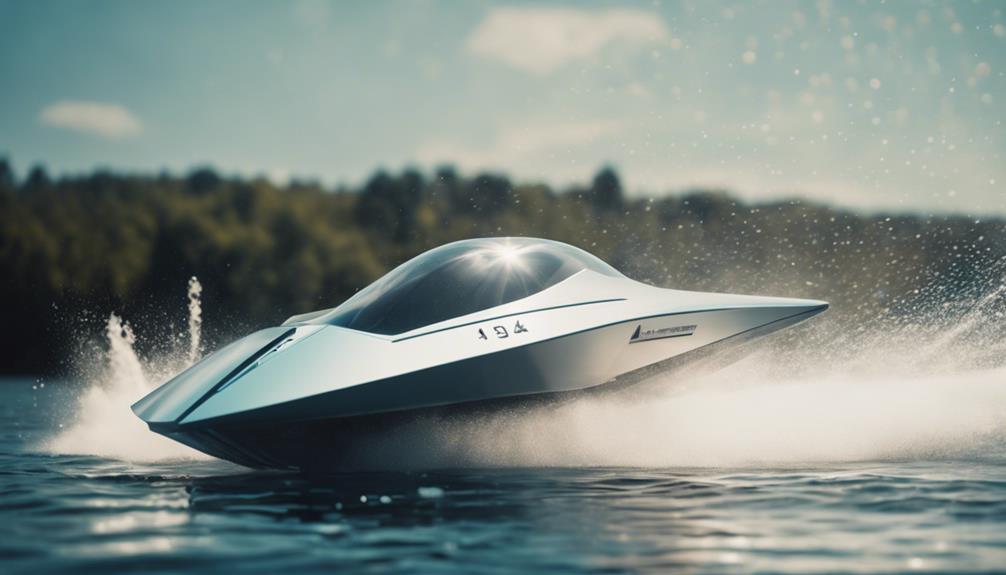
As advancements in technology continue to emerge, the quest for breaking the long-standing water speed record is more promising than ever. Ken Warby, the legendary figure behind the original Spirit of Australia, is now focusing on the Spirit of Australia II, which has already achieved a testing speed of 314 km/h (195 mph) in 2018. This ambitious project, alongside the British challenger Quicksilver, which boasts a powerful 10,000hp Mk 101 jet engine, highlights the competitive landscape.
Quicksilver is still under development, with no confirmed launch date for its record attempts. Meanwhile, the Longbow project, led by David-John Gibbs and supported by Warby's son, David Warby, demonstrates ongoing collaboration and innovation in the field. These efforts reflect a strong commitment to breaking the water speed record that has stood since Warby's original feat in 1978.
Additionally, projects like Dartagnan SP600 emerge, showcasing evolving engineering approaches that prioritize safety and speed. With these advancements, the future of jet boat racing looks bright, and competitors are more determined than ever to surpass the incredible milestone set by the Spirit of Australia.
Frequently Asked Questions
What Is the World Record Speed of a Jet Boat?
The world record speed of a jet boat is 317.6 mph, set by Ken Warby's Spirit of Australia in 1978. It's an impressive feat that's stood for over 40 years, showcasing remarkable engineering challenges.
What Is the Fastest Boat Speed Recorded?
Imagine slicing through water like a knife through butter; the fastest boat speed recorded is an astonishing 317.6 mph. This record, set by Ken Warby, still stands strong after more than four decades.
Which Is the Fastest Speed Boat in the World?
If you're curious about the fastest speedboat, it's the Spirit of Australia. It achieved an incredible two-way average speed of 317.6 mph in 1978, a record that's stood for over four decades.
What Were Donald Campbell's Last Words?
Donald Campbell's last words were, "I'm going to try for 300 miles an hour." These words reflect his relentless ambition to break speed records, ultimately leading to his tragic accident on January 4, 1967.
What Is the Speed Capability of a Mini Jet Boat Compared to the Fastest Jet Boat?
When comparing the speed capability of a mini jet boat to the fastest jet boat, there is a significant difference. The fastest jet boat can reach speeds of up to 200 miles per hour, while top mini jet boat recommendations can reach speeds of around 40-60 miles per hour. It’s all about size and power.
Conclusion
In summary, while you might think that speed is all about raw power, it's really a combination of technology and skill that defines the fastest jet boats.
The thrill of watching these machines in action is unmatched, and understanding their evolution adds to the excitement.
So, whether you're a racing enthusiast or just curious, appreciating the innovations and challenges faced by these competitors can deepen your enjoyment.
Immerse yourself in the world of jet boats—you won't regret it!


